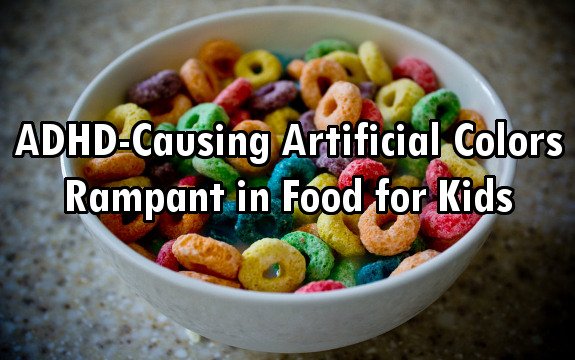Alarming Amounts of ADHD-Causing Artificial Colors Found in Kid-Popular Foods

 If you allow your child to eat highly processed foods like cereals, candy, and soft drinks, you might as well be feeding them artificial colors by the spoonful. A new study indicates these colors are present in amounts most parents wouldn’t expect, and yes, they are having an affect.
If you allow your child to eat highly processed foods like cereals, candy, and soft drinks, you might as well be feeding them artificial colors by the spoonful. A new study indicates these colors are present in amounts most parents wouldn’t expect, and yes, they are having an affect.
Research has indicated artificial food colorings to have modest effects on child attention. But this research was largely done decades ago, when the amount of coloring in foods was much smaller. Now, researchers say, many foods popular with children contain dozens of milligrams of such artificial colors in a single serving, having untold effects on our youth and ourselves.
The latest study, from researchers with Purdue University, found that breakfast cereals marketed towards children have some of the highest levels of coloring. Trix, for instance, had 36 mg. per serving and Cap’n Crunch’s OOPS! All Berries had 41. Not surprisingly, these same cereals also had high levels of sugar.
Candies were no different—with a serving of M&M’s containing 30 milligrams of artificial colors, and a serving of Skittles containing 33.
The researchers noted that the foods with the brightest colors are those that usually have the most artificial colorants. And it’s these foods that are largely marketed to kids rather than their parents. In other words, food makers are giving more of the harmful stuff to children than they are to adults.
“We don’t need to make these products appeal more to kids, kids are already obese,” said lead researcher Laura J. Stevens to Reuters Health.
A few cereals, including Special K Red Berries and Berry Berry Kix, used natural colors like strawberries and fruit juice. But food makers are largely resistant to using these colorants because they aren’t as bright and don’t stand up well to processing.
Numerous studies have identified these artificial colors as having negative effects on childhood attention and disorder. But like Joel Nigg, an expert in ADHD, points out, these studies were done decades ago when the levels of artificial colors were likely much lower than they are now.
“The dosages were average at that time but weren’t very high by today’s standard,” Nigg told Reuters. “Many of the studies have found fairly small effects, but we may be underestimating compared to what children actually get these days.”
As for the food makers, they aren’t concerned about the new research, or the old research for that matter. They seem to suspiciously put their trust in the FDA to make the right decision.
The Grocery Manufacturers Association had this to say about the latest study:
“Rest assured, if there is new data or research in this area, the FDA will review it thoroughly to determine if a change in current policy is warranted. However, the overwhelming majority of scientific evidence continues to confirm the safety of these artificial food colors.”
